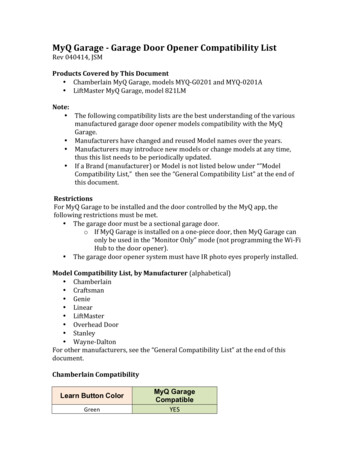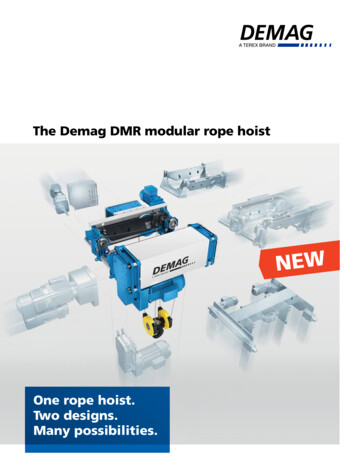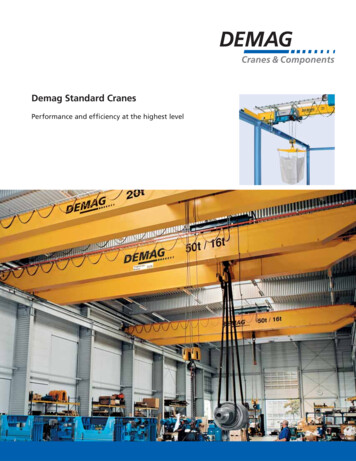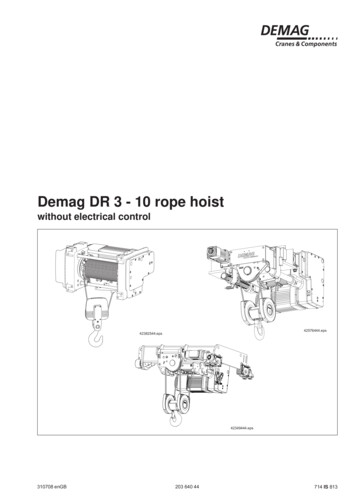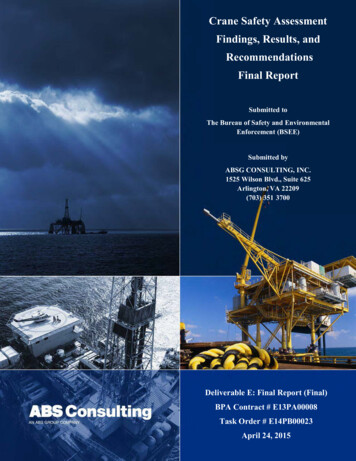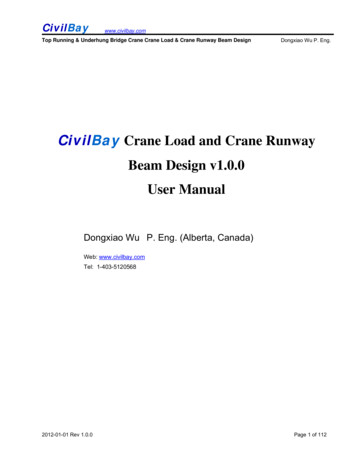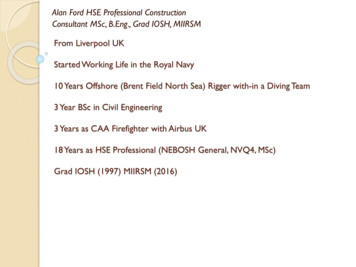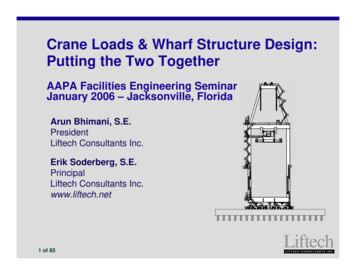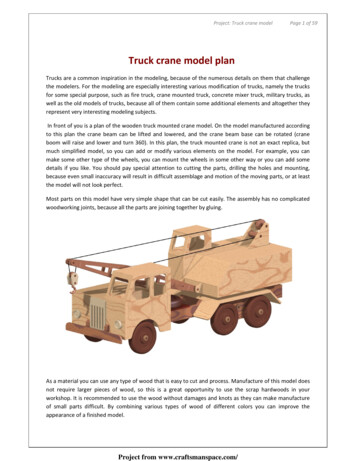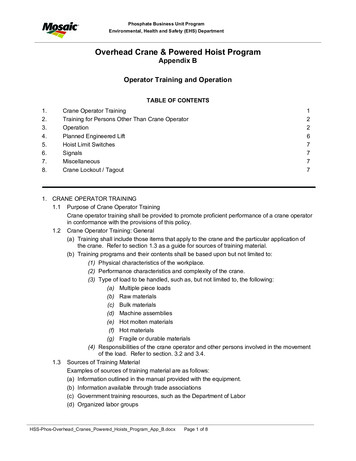
Transcription
Phosphate Business Unit ProgramEnvironmental, Health and Safety (EHS) DepartmentOverhead Crane & Powered Hoist ProgramAppendix BOperator Training and OperationTABLE OF CONTENTS1.2.3.4.5.6.7.8.Crane Operator TrainingTraining for Persons Other Than Crane OperatorOperationPlanned Engineered LiftHoist Limit SwitchesSignalsMiscellaneousCrane Lockout / Tagout122677771. CRANE OPERATOR TRAINING1.1 Purpose of Crane Operator TrainingCrane operator training shall be provided to promote proficient performance of a crane operatorin conformance with the provisions of this policy.1.2 Crane Operator Training: General(a) Training shall include those items that apply to the crane and the particular application ofthe crane. Refer to section 1.3 as a guide for sources of training material.(b) Training programs and their contents shall be based upon but not limited to:(1) Physical characteristics of the workplace.(2) Performance characteristics and complexity of the crane.(3) Type of load to be handled, such as, but not limited to, the following:(a) Multiple piece loads(b) Raw materials(c) Bulk materials(d) Machine assemblies(e) Hot molten materials(f) Hot materials(g) Fragile or durable materials(4) Responsibilities of the crane operator and other persons involved in the movementof the load. Refer to section. 3.2 and 3.4.1.3 Sources of Training MaterialExamples of sources of training material are as follows:(a) Information outlined in the manual provided with the equipment.(b) Information available through trade associations(c) Government training resources, such as the Department of Labor(d) Organized labor groupsHSS-Phos-Overhead Cranes Powered Hoists Program App B.docxPage 1 of 8
Corporate ProcedureEnvironmental, Health and Safety (EHS) Department(e) Courses, seminars, and literature offered by manufacturers of cranes, consultants, tradeschools, continuing education schools, employers, and manufacturers of crane componentparts(f) Requirements and recommendations found in National Consensus Standards such as thispolicy.2. TRAINING FOR PERSONS OTHER THAN CRANE OPERATORS2.1 ScopeOther persons, such as, but not limited to, maintenance personnel, test personnel, and craneinspectors, when it is necessary to operate a crane in the performance of their duties, shall betrained in accordance with the training requirements of this policy.3. OPERATION3.1 Scope of Crane OperationThe operation of overhead and gantry cranes shall be in accordance with the provisionsincluded in this policy and in manuals furnished by the manufacturer of the crane. Therequirements of section 3.3 (c) and (d) for certification as an operator of a crane apply to bothdedicated operators, whose primary job is the operation of a crane (cab or pulpit), and nondedicated operators who use a crane (floor or remote) as another tool in performing their job.3.2 General RequirementsThe following requirements shall be followed by all personnel involved with the crane operation:(a) A warning sign, lock, or tag that is on any switch that controls power to the crane, such as,but not limited to, the crane disconnect, motion disconnect, or runway disconnect, shall notbe removed by any person other than the person who placed the sign, lock, or tag on thedevice.(b) Warning or safety signs, labels, plates, or tags furnished on the lifting equipment shall notbe removed or obscured.(c) The crane shall not lift, lower, or travel while anyone is on the load or hook.(d) The hoist rope shall be free from kinks or twists and shall not be wrapped around the load.(e) A hook latch shall be used when provided.(f) The hook latch (when provided) shall be closed and shall not be used to support any part ofthe load.(g) The load, sling, or lifting device shall be seated in the bowl of the hook.(h) The hoist rope shall be seated in the drum grooves and the sheave grooves.(i) Persons shall stay clear of a suspended load.(j) Caution shall be exercised when using a crane having a lifting magnet, due to hazard ofpossible falling metal.(k) The crane shall be used to lift loads vertically without side pull except when specificallyauthorized by a qualified person who has determined that:(1) The various parts of the crane will not be overstressed(2) The hoist rope will not bear or rub against other members of the crane, such asgirders or trolley frame, except members specifically designed for such contact(3) Such side pulls will not cause the hoist rope to be pulled out of the sheave or acrossthe drum grooves(l) The crane shall not be used to lift loads in excess of the rated load of the crane exceptduring properly authorized tests or planned engineered lifts in accordance with Section 4.(m) A load-limiting device shall not be used to measure the weight of the load.HSS-Phos-Overhead Cranes Powered Hoists Program App B.docxPage 2 of 8
Corporate ProcedureEnvironmental, Health and Safety (EHS) Department(n) The hoist rope shall be protected so far as is practical from weld spatter or other damagingcontaminants.3.3 Responsibilities of Management (Owners/Users)Management (owners/users) shall:(a) Identify, document, and assign responsibilities of the crane operator and other personsinvolved in the movement of the load for each crane installation. (See section. 3.2 and 3.4)(b) Provide training to persons who will operate a crane.(c) Provide written and practical examinations that verify that the person has acquired theknowledge and skill to operate the particular crane(s) that will be operated by the person.The examinations shall be defined by the owner/user and in accordance with any local,state and federal provisions that may apply.(d) Issue a certificate, or formal record, that verifies that the person has been training and haspassed the examination required in para.3.3(c), or confirm that the person has a validcertificate or formal record that satisfies the requirements of section. 3.3(c).3.4 Responsibilities of Crane Operators(a) Lifting and Moving the Load(1) Three phases of lifting and moving the load shall be address as follows:(a) Before the lift(b) During the lift(c) After the lift(2) In most crane operations, all the requirements listed in section 3.4(b) are theresponsibility of the operator crane.(3) Rigging the load, attaching the load to the crane hook, and other tasks related tomoving the load are sometimes handled by persons other than the crane operator.(4) Crane operation characteristics, such as, but not limited to, the type of crane, cab, floor,pulpit, or remote operated, the vantage point of the operator, and the purpose for whichthe crane is being used are conditions that determine whether the crane operator oranother person is responsible for lift and move functions.(5) Assignment of responsibilities is determined, identified, and documented bymanagement for each crane application.(b) Before the Lift.Crane operators shall(1) Read and be familiar with the applicable provisions of crane equipment safetystandards and the instructions listed in manual(s) provided with the equipment(2) Be familiar with controls, instructions, and warnings located on the lifting equipment(3) Operate the equipment only when physically and otherwise fit(4) Not energize the main switch (crane disconnect) if a warning sign, lock, or tag is on thedevice until the sign, lock, or tag is removed by the person who placed it on the device,or by an authorized person(5) Not remove a warning sign, lock, or tag that is on any switch that controls power to thecrane, such as, but not limited to, the crane disconnect, motion disconnect, or runwaydisconnect, if the sign, lock, or tag was placed on the device by another person(6) Place all controllers in the “off” position before closing the main line disconnect device(7) Verify that no worker is on or adjacent to the crane before closing the main switch(crane disconnect)(8) Perform a functional test inspection and test in accordance with the requirements ofAppendix A, Section 1.3HSS-Phos-Overhead Cranes Powered Hoists Program App B.docxPage 3 of 8
Corporate ProcedureEnvironmental, Health and Safety (EHS) Department(9) Not remove or obscure the warning or safety labels, plates, or tags furnished on thelifting equipment(10) Be familiar with and understand hand signals (See Section 6 and Fig. 6.1-1)(11) Verify that the hook, bridge, and trolley travel in the same direction as shown on thecontrols(12) Verify that the hoist rope is free from kinks or twists and is not wrapped around the load(13) Attach the load to the hook or have the load attached to the hook by means of slings orother lifting devices(14) Verify that the load, sling, or lifting device is seated in the bowl of the hook(15) Use a hook latch when provided(16) Verify that the hook latch (when provided) is closed and not supporting any part of theload(17) Verify that the rope is seated in the drum grooves and in the sheave(s) grooves if thereis or has been a slack rope condition(18) Activate the warning device (when a device is furnished)(a) Before starting the bridge or trolley motion of the crane(b) Intermittently during travel of the crane when approaching persons in the pathof the load(19) Board the crane (cab) only at authorized locations and designated boarding entrances(20) Verify that the transmitter selected is the correct transmitter for the crane to beoperated(c) During the Lift.Crane operators shall(1) Respond to signals from the person directing the lift or a designated signal person(2) Be responsible for the lift when a signal person is not used(3) Obey any “stop” signal regardless of who gives it(4) Lift a load only if its weight and the weight of any lifting device are within the rated loadof the crane and hoist(s) as marked on the crane and hoist load block or load blocks.(a) The operator shall verify the weight of the total load if there is a questionwhether the total load to be lifted exceeds the rated load of the crane and/orhoist(s).(b) The operator shall not use a load-limiting device to measure the load.(c) A total load exceeding the rated load shall not be lifted except during properlyauthorized tests or planned engineered lifts in accordance with Section 4.(5) Stop the crane’s functions in a controlled manner when the operator has doubt as to thesafety of crane operations. Lift operations shall resume only after the safety concernshave been addressed.(6) Verify multiple part lines are not twisting around each other when the lift is made.(7) Take up slack rope carefully, lift the load a few inches (cm) to check the load holdingbrake action, and verify that the load is secured, balanced, and positioned on the hookand in the sling or lifting device.(8) Minimize swinging of the load or load hook.(9) Maintain firm footing when operating lifting equipment.(10) Avoid sudden acceleration and deceleration of the load.(11) Use the crane to lift vertically, without side pull, except when specifically authorized by aqualified person who has determined that(a) The various parts of the crane will not be overstressedHSS-Phos-Overhead Cranes Powered Hoists Program App B.docxPage 4 of 8
Corporate ProcedureEnvironmental, Health and Safety (EHS) Department(b) The hoist rope will not bear or rub against other members of the crane, such asgirders or trolley frame, except members specifically designed for such contact(c) Such side pulls will not cause the hoist rope to be pulled out of the sheaves oracross drum grooves(12) Verify that the load and rigging are free to move and will clear all obstructions.(13) Check the hoist brake (s), if a load approaching the rated load is to be handled, bylifting the load a short distance and applying the brake(s).(14) Stop the lifting of the load before the upper limit device is engaged. The hoist limitdevice that controls the upper limit of travel of the load block shall not be used as anoperating control in normal operation unless additional means are provided to preventdamage from over-travel.(15) Avoid carrying loads over people.(16) Concentrate on operating the crane and shall not allow attention to be diverted whileoperating the crane.(17) Activate the warning device (when a device is furnished)(a) Before starting the bridge or trolley motion of the crane(b) Intermittently during travel of the crane when approaching persons in the pathof the load(18) Promptly report, to the person responsible for the crane, any malfunction, unusualperformance or sound, or damage of equipment that could indicate the need foradjustment, repair, or replacement in order to maintain proper operation.(19) Contact runway stops or another crane with caution for the safety of the operator andpersons on or under the cranes.(20) Warn persons on or under a crane when contact is to be made with another crane priorto contact being made.(21) Place all controllers or master switches is the “off” position when power is interruptedduring normal operation.(22) Check the controllers for correct direction of motion when power is restored after apower outage.(23) Follow the directions of the designated person in charge of the operation when two ormore cranes are used to lift a load.(24) Not leave a suspended load unattended unless provisions have been made to provideauxiliary supporting means under the suspended load, or guards or barriers are utilizedon the floor to prevent people from entering the area affected by the suspended load.(25) Not lower the load below the point where two wraps of rope remain on each anchorageof the hoisting drum unless a lower-limit device is provided, in which case no less thanone wrap shall remain.(26) Stop the lowering of the load before the lower-limit device, if furnished, is engaged.The lower-limit device shall not be used as an operating device during normaloperation.(27) Properly secure an outdoor overhead or gantry crane when the wind indicating alarm isactivated in accordance with the requirements listed.(28) Use the harness or belt, if provided, for use with the transmitter or place the transmitterin the location intended for its support.(29) Not override safety devices on the transmitter.(30) Not wear gloves that interfere with the operation of the controls.(31) Shut off the transmitter when a power failure occurs.(d) After the Lift.HSS-Phos-Overhead Cranes Powered Hoists Program App B.docxPage 5 of 8
Corporate ProcedureEnvironmental, Health and Safety (EHS) DepartmentCrane operators shall(1) Lift the load block and attachments above the highest movable obstruction under thecrane when the crane is not in use.(2) Notify the next operator if required adjustment, repair, or replacement has not beenmade.(3) Properly secure an outdoor overhead or gantry crane when the crane is shut down.(4) Open the crane main line disconnect device and the magnet disconnect switch (whenapplicable) before leaving the crane cab.(5) Place the controllers in the “off” position, before leaving the crane cab.(6) Shut off the power to pendant-operated cranes before leaving area. Shut off and storetransmitter in a designated and protection location.4. PLANNED ENGINEERED LIFTLifts in excess of the rated load may be required from time to time on a limited basis for specificpurposes, such as new construction or major repairs. Every planned engineered lift exceeding therated load shall be treated as a special and separate event. Limitations and planned requirementsshall be applicable as follows:(a) Planned engineered lifts shall be limited to powered cranes having a load rating of five tons andabove.(b) When planned engineered lifts are made, the load shall not exceed 125% of the crane loadrating, except as provided in section. 4(d).(c) Planned engineered lifts shall be limited to two occurrences on any crane within any continuous12-month period, except as provided in 4(d). If greater lift frequency is desired, considerationshall be given to rerating or replacing the crane.(d) The crane manufacturer shall be consulted if the planned engineered lift exceeds 125% of ratedload or if the frequency of planned engineered lifts exceeds two during a continuous 12-monthperiod.(e) Each planned engineered lift shall comply with the following requirements:(1) A written review of the crane service history shall be prepared, including reference toprevious planned engineered lifts, structural repairs, and modifications of originaldesign.(2) The design of the structural, mechanical, electrical, pneumatic, and hydraulic components ofthe crane shall be reviewed by means of applicable calculations for the load to be lifted andapproved by the crane manufacturer or a qualified person, in accordance with accepted cranedesign standards if the load to be lifted exceeds 125% of rated load or if the frequency ofplanned engineered lifts exceeds two during a continuous 12-month period.(3) The design of the crane-supporting structure shall be reviewed and approved by a qualifiedperson for conformance to applicable design criteria. The crane support shall be inspectedand any deterioration or damage shall be taken into consideration in design calculations forthe load to be lifted.(4) The crane shall be inspected in accordance with Appendix A, section. 1.5 Just prior to makingthe lift.(5) The lift shall be made under controlled conditions under the direction of a designated person inaccordance with a previously prepared lift plan. All persons in the area of the crane shall bealerted that the lift is being made.(6) The operator shall test the crane at the planned engineered load by lifting the load a shortdistance and setting the brakes. The lift shall only be continued if the brake stops and holdsthe load. Any failure to hold the load shall be corrected before proceeding with the lift.HSS-Phos-Overhead Cranes Powered Hoists Program App B.docxPage 6 of 8
Corporate ProcedureEnvironmental, Health and Safety (EHS) Department(7) The crane shall be inspected in accordance with Appendix A, para.1.5 after the lift iscompleted and prior to being used for the lifting of any other load.(8) A record of the planned engineered lift, including calculations, inspections, and all distancesmoved, shall be placed on file for availability to appointed personnel.(f) The rated load test specified in Appendix A, section 3.2 is not applicable to planned engineeredlift provisions.5. HOIST LIMIT DEVICES (SWITCHES)(a) Prior to the initial use of any hoist during each shift, the operator shall verify operation of theupper limit device under no-load conditions. If more than one upper limit device is present, onlythe operation of the primary upper limit device needs to be verified. Care shall be exercised; theblock shall be inched into the limit or run at slow speed. If the device does not operate properly,the operator shall immediately notify the appointed person.(b) The hoist limit device that controls the upper limit of travel of the load block shall not be used asan operating control in normal operation unless additional means are provided to prevent damagefrom over-travel.6. SIGNALS6.1 Standard Signals(a) Signals to the operator shall be in accordance with this policy, unless voice communication(telephone, radio, or equivalent) is utilized.(b) Signals should be discernible or audible to the operator.(c) Hand signals shall be posted conspicuously and should be as illustrated in Fig. 6.1-1.6.2 Special Signals(a) Special operations may require additions to or modifications of standard signals.(b) Special signals shall be agreed upon and understood by the signal person and the operator(c) Special signals shall not conflict with standard signals.7. MISCELLANEOUS7.1 Ladders(a) Hands shall be free from encumbrances while personnel are using ladders.(b) Articles that are too large to be carried in pockets or tool belts shall be lifted and lowered byhand line.7.2 Cabs(a) Necessary clothing and personnel belongings shall be stored in a manner that does notinterfere with access or operation.(b) Tools, oil cans, rags, and other necessary articles shall be stored in the fire-resistantcontainer and shall not be permitted to lie loose in or around the cab.7.3 Fire ExtinguishersOperators shall be familiar with the location, operation, and care of fire extinguishers provided.8. CRANE LOCKOUT/TAGOUT8.1 General(a) A Lockout/Tagout policy and procedure shall be developed, documented, and implementedby the owner or user of overhead cranes.HSS-Phos-Overhead Cranes Powered Hoists Program App B.docxPage 7 of 8
Corporate ProcedureEnvironmental, Health and Safety (EHS) Department(b) The Lockout/Tagout policy and procedure shall comply with the requirements of ANSIZ244.1.(c) The policy shall give consideration to the following areas:(1) Single-crane runways(2) Multiple-crane runways(3) Cranes on an adjacent runway(4) Runway disconnecting means(5) Crane disconnecting means(6) Work to be done on the crane(7) Work to be done other than on a crane but with the path of a crane where itsmovement creates a hazardHSS-Phos-Overhead Cranes Powered Hoists Program App B.docxPage 8 of 8
1. CRANE OPERATOR TRAINING 1.1 Purpose of Crane Operator Training Crane operator training shall be provided to promote proficient performance of a crane operator in conformance with the provisions of this policy. 1.2 Crane Operator Training: General (a) Training shall include those items that apply to the crane and the particular application of
